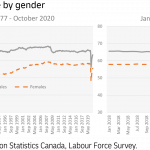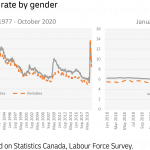
Sarah Kring has had to reduce her hours in order to care for her two children during the pandemic.
By Laural Samson
BELLEVILLE – The pandemic is starting to show its gendered colours as reports show that women are more likely to lose their job, leave their job, or reduce their hours due to COVID-19- and Sarah Kring, a local mother of two, has experienced this first-hand.
In order to care for her two girls, ages two and five, Kring had to go from working full-time for Gleaners Food Bank to part-time work.
“Being in the middle of the pandemic, where you have small children that can’t take care of themselves, it comes to a kind of crosshair of who do you give the most support to- whether or not that’s your family, or whether or not that’s your employer.”
A study done by RBC [1] revealed that mothers with children under six account for two-thirds of the women who’ve left the workforce since the pandemic began.
Kring also said that making the decision to stay home was hard, but it made sense since her husband has the higher-paying job.
“It’s a very difficult decision to come across, number one, but to do what’s best not just for yourself but for your family and your employer at the same time, without fear of losing your job.” Kring said, adding that when she made the decision to reduce her hours to stay at home with her children, she felt sorry about it.
“I felt a little bit remorseful that I would be leaving my coworkers.” Kring said this was because she knew that with the volunteers also gone from Gleaners, her absence would put more stress on her coworkers to fill the gap.
Kring is hopeful that she can go back to full-time work for July, but it is still a difficult decision.
Jennifer May Anderson, the president of the Business and Professional Women Trenton & District Club, spoke about why Kring’s decision is not unusual for women during the pandemic.

Jennifer May Anderson speaks on the data that shows women’s jobs are being hit harder by the pandemic.
“Across Canada, women have accounted for 63% of the one million jobs that have been lost, [2] and 70% of job losses by workers 25-54.”
According to the RBC study [1], more than 20, 000 women left the workforce between February and October while about 68, 000 men joined it.
“One of the reasons for that are that women are staying home to care for children, with schooling sometimes being online. We also know that, especially in the early days of the pandemic, a lot of women work in service jobs and retail jobs and those kinds of things, and those are the sectors that were being really affected by closures.” Anderson said.
http://www.qnetnews.ca/wp-content/uploads/2021/01/63-Queen-St-7.m4a [3]And while Kring hopes to get back to work soon enough, Anderson says that many women will not have the same luxury of returning to work after the pandemic dies down.
“The United Nations has issued a policy brief [4] and they think that the gains that women have made over the past decade may take many years to catch up to where we were. They think that there is going to have to be a lot of work around gender equality if our social and economic recovery efforts are going to return women to the place where they were in society.”
In September last year, United Nations Secretary-General Antonio Guterres stated that COVID-19 sought to reverse "decades of limited and fragile progress on gender equality and women’s rights."https://t.co/tBmecIIy1b [5]
— SheThePeople (@SheThePeople) January 12, 2021 [6]
One of the reasons that women were so quick to leave the workforce is because of the way the system is set up, Anderson said.
“When the system isn’t equitable to begin with, then any gains that you make erode more quickly.” Anderson said, adding that an example is how quickly women fell back into the caretaker role when childcare wasn’t available.
And while the pandemic has shown that when it comes to job losses women are hit harder, it’s also clear that women from different races are more seriously affected.
“Even amongst women, there is diversity in how the pandemic has affected women.” Anderson said.
In an article published to CTV [7] in December, official data showed that the unemployment rate for minority women is 10.5%, while the rate is only 6.2% for white women.
“It’s not just women, but all the different kinds of women and how they are being affected too.”
The question of men, and how they are included in the job losses due to the pandemic, cannot be ignored either.
“The pandemic has affected everyone and it certainly has affected men too.” Anderson said.
In the data shown below [8], it’s clear that the female unemployment rate is higher than men’s during the beginning of the pandemic.
However, on the left in Figure 1, it’s important to note that women’s employment has not been permanently reduced by recent recessions, while men’s employment seems to have experienced more permanent effects from recessionary shocks.
And while this is something to follow in the upcoming months, Anderson says that the COVID-19 recovery process will need to include a ‘women lens’.
“One of the things that we have to do is take this as an opportunity to see how women have been affected.”
http://www.qnetnews.ca/wp-content/uploads/2021/01/63-Queen-St-7-copy.m4a [11]As one of the women affected, Kring says that she isn’t surprised by the data, since there is more pressure on women to try and get everything done.
“I wouldn’t be surprised if females lose their jobs, especially the ones that have children, because they are more than likely going to choose their family over their employment, regardless of the financial strain that it may put on them.” Kring also shared a post that she had seen that summed up her dilemma of caring for children while still trying to work her reduced hours.
“We are expected to work as if we have no children, and we are expected to mother like we have no job.”

